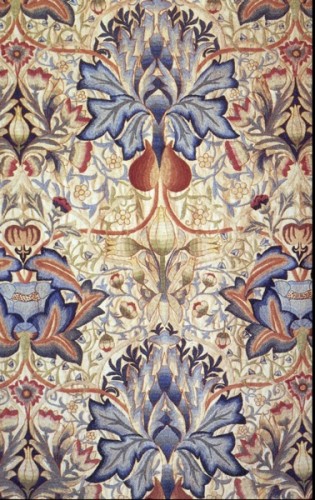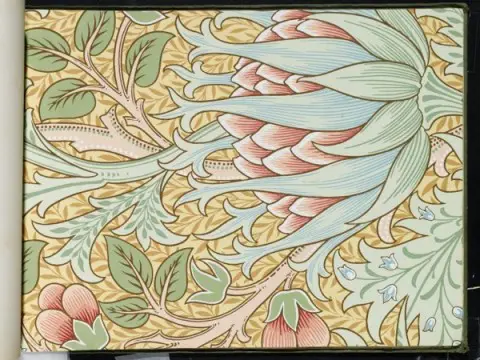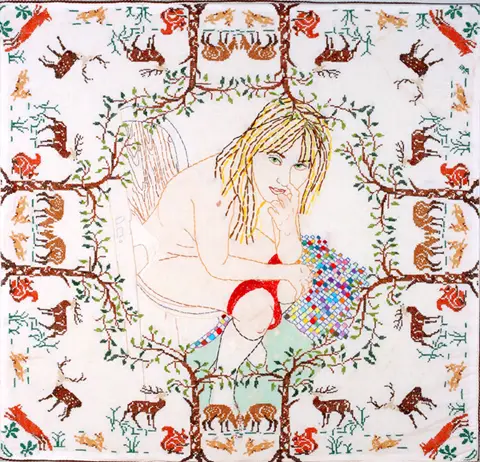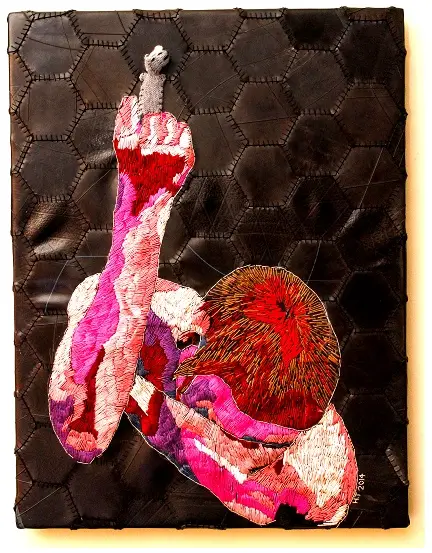Welcome back everybody! I thought we talk about William Morris today. As there are many, many, articles about him readily available online, I thought it would be interesting to write about a series of lectures he gave in the late 1870’s. You can read them in their entirety HERE. I know that 1870 seems like a long way away, but that’s what I’m about on Needle Exchange, and I found the lectures to still be quite relevant.
William Morris
Of course these talks are long, and I only have so much space, so I’ve decided to cherry pick a few of the passages from from the talk “The Lesser Arts”. Again, I hope you’ll click the link to read the complete lectures.
From “The Lesser Arts”-
“Now as to the scope and nature of these Arts I have to say, that though when I come more into the details of my subject I shall not meddle much with the great art of Architecture, and less still with the great arts commonly called Sculpture and Painting, yet I cannot in my own mind quite sever them from those lesser so-called Decorative Arts, which I have to speak about: it is only in latter times, and under the most intricate conditions of life, that they have fallen apart from one another; and I hold that, when they are so parted, it is ill for the Arts altogether: the lesser ones become trivial, mechanical, unintelligent, incapable of resisting the changes pressed upon them by fashion or dishonesty; while the greater, however they may be practised for a while by men of great minds and wonder-working hands, unhelped by the lesser, unhelped by each other, are sure to lose their dignity of popular arts, and become nothing but dull adjuncts to unmeaning pomp, or ingenious toys for a few rich and idle men.”
To begin with, I find this not only to be historically true, but an observation that is still relevant today. Giorgio Vasari is largely responsible for the split and subsequent definition of “Fine” and “Decorative/Lesser” arts, however this definition can be considered novel when we consider that in many cultures there is no distinction, and until fairly recently, mediums such as Tapestry were considered “fine”rather than “decorative””. I think what Morris is getting at is by elevating one method of creating over another, does neither field any favors, and ultimately demeans them both. If we can’t see past the method or the materials, how are we to accurately judge the final product?
“A very great industry indeed, comprising the crafts of house- building, painting, joinery and carpentry, smiths’ work, pottery and glass-making, weaving, and many others: a body of art most important to the public in general, but still more so to us handicraftsmen; since there is scarce anything that they use, and that we fashion, but it has always been thought to be unfinished till it has had some touch or other of decoration about it. True it is that in many or most cases we have got so used to this ornament, that we look upon it as if it had grown of itself, and note it no more than the mosses on the dry sticks with which we light our fires. So much the worse! for there IS the decoration, or some pretence of it, and it has, or ought to have, a use and a meaning. For, and this is at the root of the whole matter, everything made by man’s hands has a form, which must be either beautiful or ugly; beautiful if it is in accord with Nature, and helps her; ugly if it is discordant with Nature, and thwarts her; it cannot be indifferent: we, for our parts, are busy or sluggish, eager or unhappy, and our eyes are apt to get dulled to this eventfulness of form in those things which we are always looking at. Now it is one of the chief uses of decoration, the chief part of its alliance with nature, that it has to sharpen our dulled senses in this matter: for this end are those wonders of intricate patterns interwoven, those strange forms invented, which men have so long delighted in: forms and intricacies that do not necessarily imitate nature, but in which the hand of the craftsman is guided to work in the way that she does, till the web, the cup, or the knife, look as natural, nay as lovely, as the green field, the river bank, or the mountain flint.”
I find this section terribly obvious, but the sentiment is generally over looked. Decorative work is inescapable, and a huge industry. Everything from an iPhone cover, to a picture frame from Target, to the draw pulls at Ikea, each was made with some decorative element in mind. When people regard crafting as frivolous, they are being laughably unobservant. Obviously, Morris’ thoughts on aesthetics reflect his own preferences, but we can hardly ignore that some of the most recognizable motifs found in decorative works are derived from nature, from the arabesque to the feather stitch.
“To give people pleasure in the things they must perforce USE, that is one great office of decoration; to give people pleasure in the things they must perforce MAKE, that is the other use of it. Does not our subject look important enough now? I say that without these arts, our rest would be vacant and uninteresting, our labour mere endurance, mere wearing away of body and mind.”
This statement gets to the heart of it. What a huge power it is to provide someone some small pleasure in dull work by providing them with a beautiful tool, and to those of us who are makers, how fortunate we are that even though the work we do is often difficult and time consuming, it is more than “mere endurance, mere wearing away of body and mind”.
Moving on-
“People say to me often enough: If you want to make your art succeed and flourish, you must make it the fashion: a phrase which I confess annoys me; for they mean by it that I should spend one day over my work to two days in trying to convince rich, and supposed influential people, that they care very much for what they really do not care in the least, so that it may happen according to the proverb: Bell-wether took the leap, and we all went over. Well, such advisers are right if they are content with the thing lasting but a little while; say till you can make a little money””if you don’t get pinched by the door shutting too quickly: otherwise they are wrong: the people they are thinking of have too many strings to their bow, and can turn their backs too easily on a thing that fails, for it to be safe work trusting to their whims: it is not their fault, they cannot help it, but they have no chance of spending time enough over the arts to know anything practical of them, and they must of necessity be in the hands of those who spend their time in pushing fashion this way and that for their own advantage.”
This fascinates me. Keeping in mind that this was written nearly 140 years ago, I’m blown away by how relevant this is today. Although this sort of thing is found in the art world to a lesser degree (Mr. Brainwash?), I see it over and over again in the crafting world. Etsy forums are mired in threads of “Why isn’t this selling?”and “On trend” and “How to promote”. Actually, the existence of Etsy essentially proves the point. The modern day crafting movement as a whole always has an eye fixed on the financial, whether it’s DIY (why buy if you can make?) or “Buy handmade! Vote with your dollar!” Unfortunately, this mentality runs the risk of breeding homogeneity, unoriginality, and knock offs.
Morris’ solution is a simple one-
“Sirs, there is no help to be got out of these latter, or those who let themselves be led by them: the only real help for the decorative arts must come from those who work in them; nor must they be led, they must lead. You whose hands make those things that should be works of art, you must be all artists, and good artists too, before the public at large can take real interest in such things; and when you have become so, I promise you that you shall lead the fashion; fashion shall follow your hands obediently enough.”
I have to say this reminds me of a wonderful piece that Paul Overton wrote on his blog Dude Craft- Click HERE
Morris goes on to say, “That is the only way in which we can get a supply of intelligent popular art: a few artists of the kind so-called now, what can they do working in the teeth of difficulties thrown in their way by what is called Commerce, but which should be called greed of money? working helplessly among the crowd of those who are ridiculously called manufacturers, i.e. handicraftsmen, though the more part of them never did a stroke of hand-work in their lives, and are nothing better than capitalists and salesmen. What can these grains of sand do, I say, amidst the enormous mass of work turned out every year which professes in some way to be decorative art, but the decoration of which no one heeds except the salesmen who have to do with it, and are hard put to it to supply the cravings of the public for something new, not for something pretty?”
Who hasn’t heard horror stories of someone having their work badly mass produced? It’s fairly common to spot cheap goods gleefully masquerading as handmade even in marketplaces that profess only to sell handmade items. These problems are unlikely to go away completely, but I do believe that the solutions that Paul Overton and William Morris propose can significantly change the tide.
William Morris wallpaper
“For your teachers, they must be Nature and History: as for the first, that you must learn of it is so obvious that I need not dwell upon that now: hereafter, when I have to speak more of matters of detail, I may have to speak of the manner in which you must learn of Nature. As to the second, I do not think that any man but one of the highest genius, could do anything in these days without much study of ancient art, and even he would be much hindered if he lacked it. If you think that this contradicts what I said about the death of that ancient art, and the necessity I implied for an art that should be characteristic of the present day, I can only say that, in these times of plenteous knowledge and meagre performance, if we do not study the ancient work directly and learn to understand it, we shall find ourselves influenced by the feeble work all round us, and shall be copying the better work through the copyists and WITHOUT understanding it, which will by no means bring about intelligent art. Let us therefore study it wisely, be taught by it, kindled by it; all the while determining not to imitate or repeat it; to have either no art at all, or an art which we have made our own.”
I find this to be incredibly important. If I ever had a pet project or mission statement, it would be a version of that statement. I see such appalling ignorance on a daily basis that could easily be remedied by a cursory glance at art history. As participants in a creative field, it can only help our work, our critiques, and our palettes.
“Of course, however, both as an instrument of that study we have been speaking of, as well as of the practice of the arts, all handicraftsmen should be taught to draw very carefully; as indeed all people should be taught drawing who are not physically incapable of learning it: but the art of drawing so taught would not be the art of designing, but only a means towards THIS end, GENERAL CAPABILITY IN DEALING WITH THE ARTS… As to the kind of drawing that should be taught to men engaged in ornamental work, there is only ONE BEST way of teaching drawing, and that is teaching the scholar to draw the human figure: both because the lines of a man’s body are much more subtle than anything else, and because you can more surely be found out and set right if you go wrong. I do think that such teaching as this, given to all people who care for it, would help the revival of the arts very much: the habit of discriminating between right and wrong, the sense of pleasure in drawing a good line, would really, I think, be education in the due sense of the word for all such people as had the germs of invention in them; yet as aforesaid, in this age of the world it would be mere affectation to pretend to shut one’s eyes to the art of past ages: that also we must study.”
I absolutely agree with this. I hear people all the time say, “But I suck at drawing!” So what? Why would you let that stop you? It probably took ages to get proficient at needlework, and that didn’t stop us. Spending a bit of time becoming familiar with drawing only can only help in the other work, even if one never becomes a master, or even adequate. The willingness to explore, to fail, to learn, to take risks, and maybe be surprised, can’t help but improve the work we are confident in. This is an investment in our skills, in our work, and it only helps to combat Morris’ next point-
“There is a great deal of sham work in the world, hurtful to the buyer, more hurtful to the seller, if he only knew it, most hurtful to the maker: how good a foundation it would be towards getting good Decorative Art, that is ornamental workmanship, if we craftsmen were to resolve to turn out nothing but excellent workmanship in all things, instead of having, as we too often have now, a very low average standard of work, which we often fall below.”
Finally- “I do not want art for a few, any more than education for a few, or freedom for a few.”
 William Morris embroidered panel
William Morris embroidered panel
———————-
Penny Nickels is a printmaker that started playing with needles with tremendous effect. She and her husband, Johnny Murder, have been described as the “Bonnie and Clyde of Contemporary Embroidery“and you can discover the power of her creativity at her blog.
———————
All sources sited in this article can be found via the highlighted links.






